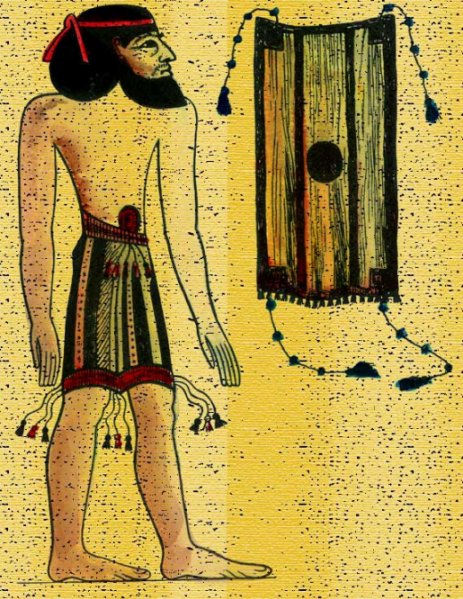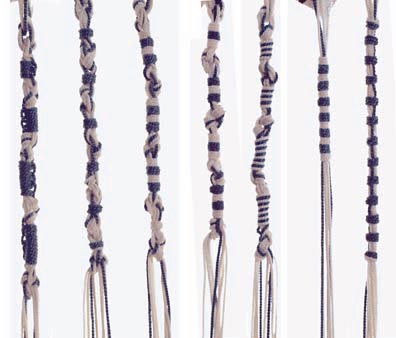


 631
Tzitzit
631
Tzitzit

What are They and Who Should Wear Them?

Tzitzit or tassels are to be worn by all men on the four corners of their chief garment (Num.15:38-39; Dt.22:12). The form or length of the tassels is not specified - all that is required is a blue cord. Why blue? Because the Throne of Yahweh is on a sea of blue saphire. The blue cord is therefore to remind all Israel that the men are given authority as heads of marriages and families, and the men that they have this authority only so long as they are subject to Torah. Yah'shua wore tzitzit (Mt.9:20; 14:36) which were points of healing for those who had faith. He rebuked the Pharisees for wearing extra-long tassels to show off their outer righteousness.
In Messianic Judaism, some women wear tzitzit too. This is a perversion of the divine symbolism because the tzitzit are a sign of the Priesthood and denote, collectively, Yahweh's "Kingdom of Priests" (Ex.19:6). Women, of course, are Priestesses in the New Covenant, but in subjection to their husbands - which is denoted by their head-covering - and not independently of them.
I could show you tzitzit as worn by orthodox Jews (they have no blue cord in them), by Karaite Jews or by Messianic Jews, with all their elaborate knots and weavings which they respectively say are the 'correct' way but which in truth derive from the so-called oral tradition of the talmudists, but they would not necessarily be correct. To see examples of tzitzit see the image below:

From what we know, there does not seem to have been a fixed pattern and nobody knows how they were made in Moses' day. Traditions doubtlessly evolved. Unfortunately, there is not a lot of ancient art work preserved except of some Jews in captivity. One example may bbe found at the top of this article.
As you can see, this is very different from modern traditions, and even traditions going back over the last two millennia. I have seen other pictures but can't locate them - when I do, I will publish them here. But basically the other pictures I have seen interpret the "four corners" to be the two sleaves and the hem of the long robe by the feet.
Many Messianics claim that women should have the right to wear tzitzit too. There is, however, no evidence before the advent of Yah'shua, or in the early Messianic Community, that women wore them. Women wearing tzitzit is a relatively modern innovation in both Judaism and Messianism. Talmudic authority Maimonides, in his Mishneh Torah (Hilchot Tzitzit 3:9) says:
"Women, slaves and minors are exempt from tzitzit according to the Torah ... Women and slaves who wish to wrap themselves in tallit may wrap themselves without making a blessing. And thus with other timebound, positive commandments from which women are exempt: if they wish to fulfil them without making a blessing, then you don't prevent them".
which gives us some idea of the prevalent views from that (post-Messianic) time period.
The strictest position is that of Epstein in Aruch Hashulchan (Orach Chayyim 17:3). He examines the rabbis' acceptance of women performing other timebound, positive mitzvot, such as the shaking of the lulav, and raises no objections. But in his eyes tallit is different. First, the other timebound mitzvot are matters of chovat gavra (personal obligation), whereas tallit for women is not, and so they have more importance. Second, the shaking of the lulav and the hearing of the shofar occur only once in a year, but wearing the tallit is a daily commandment according to their tradition. He then says: "It is not fitting for a woman to wear tallit ..." and his arguments lead him to ask: "How can we allow women to wear a tallit?"
This, of course, presumes that Tallit-wearing is a Torah commandment...which it is not.
Professor Milgrom of Berkeley University, who wrote one of the critical volumes of commentary on the Torah for the Jewish Publication Society, saw the tzitzit as a sign of royalty or the Priesthood. They were worn on the lower hem of the robe, and thus we are a "kingdom of priests" seeing themselves as a light unto the world. This is my view. And this is why, though women are Priestesses in subordinate partnership with their husbands, I believe women cannot wear tzitzit. (The nature of Tallit is another question - the design prescriptions which we see in both Judaism and Messianism are for the most part Talmud-derived and based on evolving tradition and rabbinical law-making).
The earliest references to women being allowed to wear tallit and tzitzit are from no more than a thousand years ago, a full millennium after the beginning of the Messianic era. Sourses which discuss this issue in Judaism are: Isaac ibn Ghiyyat (b. 1038), Rashi (1040-1105), Rabbenu Tam (ca. 1100-1171), Zerachya ben Yitzhak Halevi of Lunel (ca 1125-1186), Rambam (1135?1204), R. Eliezer ben Yoel Halevi (ca 1140-ca 1225), Rashba (1235?1310), Aharon Halevi of Barcelona (b. ca 1235?), R. Yisrael Yaaqob Alghazi (1680-1761).
Historically, then, there is no evidence of this practice until recent times, and then outside the Messianic movement. Spiritually, since it denotes both a priesthood accountability, headship and commandment-keeping remembrance, it can only belong to men. Women have their own unique sign and blessing which Yahweh has given them - the head-covering.
How should men wear tzitzit in our modern day and age since:
- 1. We have very different clothing habits to the ancients? and
- 2. Tallit or Jewish prayer shawls are a modern, post-Messianic invention of Judaism?
There are three methods of wearing tzitzit (that do not use tallit) that seem to me to be equally valid:
- 1. Wearing them on the belt of trousers (most common);
- 2. Wearing them on the ends of a scarf worn around the neck (becoming more popular); or
- 3. Wearing them on the hem of a shirt outside the trousers (least popular and impactical in cold climates).
What we should not be doing is imitating Talmudic Judaism as most Messianics do. This was not the religion of Yah'shua, the apostles or the first New Covenant believers. That they wore tzitzit is undisputed, that they worm them on tallit is impossible because tallit did not yet exist in their times and were created by the rabbis to distinguish non-Messianic Jews from Christian/Messianic men who did not cover their head whilst praying, as Paul taught:
"Now I praise you, brethren, that you remember me in all things and keep the traditions just as I delivered them to you. But I want you to know that the head of every man is Christ, the head of woman is man, and the head of Christ is Elohim (God). Every man praying or prophesying, having his head covered, dishonours his head. But every woman who prays or prophesies with her head uncovered dishonors her head, for that is one and the same as if her head were shaved. For if a woman is not covered, let her also be shorn. But if it is shameful for a woman to be shorn or shaved, let her be covered. For a man indeed ought not to cover his head, since he is the image and glory of Elohim (God); but woman is the glory of man" (1 Cor.11:2-7, NKJV).
As Messianic Evangelicals we should obey Torah but not Jewish traditions. Therefore grown men believers - and believing boys at the age of 12 - should wear tzitzit in obedience to the commandment and according to the pattern revealed in Scripture. We should not use or imitate tallit which are contrary to Scripture.
Comments from Readers
[1] "Wow, someone else has the same understanding as I! The Tzitzit command is for the sons of Yisrael...the spiritual heads!" (VH, Canada, 27 February 2023)


This page was created on 23 August 2010
Last updated on 28 February 2023
Copyright © 1987-2023 NCAY




